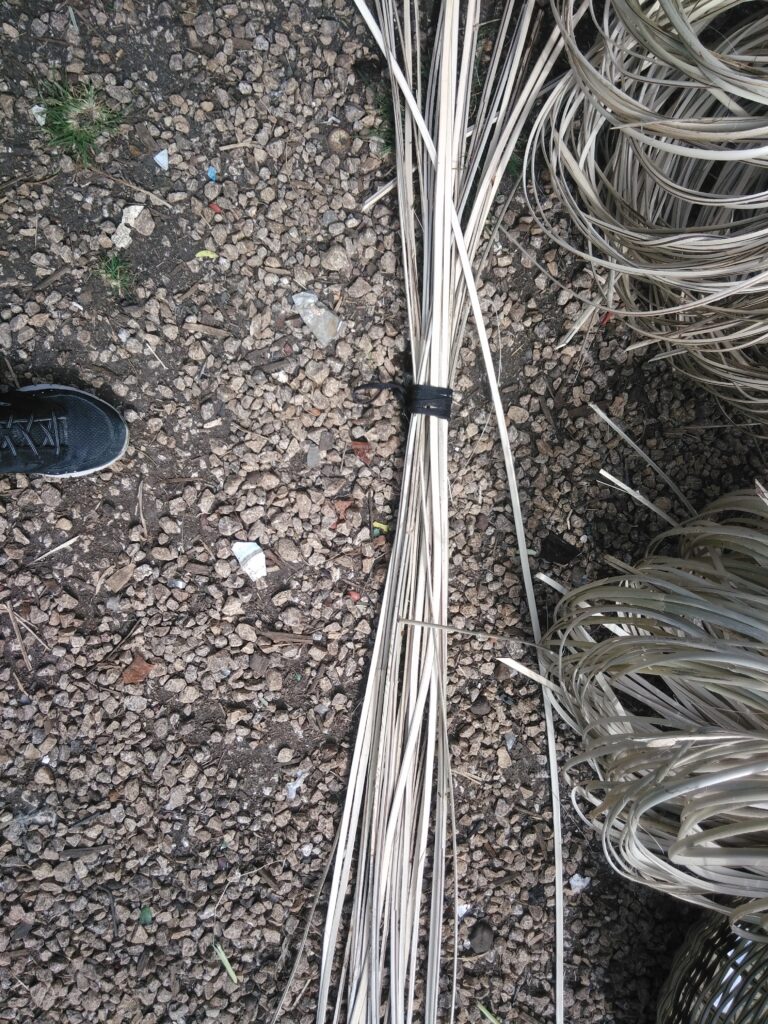Description
Titai weaving is a skill that is practiced in rural communities in the Cayo and Belize District. Titai weaving is used for the production decorative artisan pieces such as key chains and earrings, as well as useful household implements such as clothing hampers, fruit bowls, coasters, and other implements.
The main element used for titai weaving is the titai vine. This vine grows in swamp areas or near water sources. The vines are slender, long and have thorns which must be removed when preparing the vines for use. After retrieving the titai vine, the vine is cleaned removing all thorns and leaves. The vine is then left to dry for at least a day. Once the vine is dry, it is stripped and cut into thin quarters. The strips are no longer round but have a flat and thin surface. The strips are cut into different lengths depending on what it will be used to create, i.e. hampers, fruit bowls, or key-chains, etc. The platting begins with setting the base, which is the most difficult step in elaborating the desired object; as the vines are weaved, the desired object begins to take shape. The time it takes to make a titai object varies depending on the size of the desired object; hampers, large baskets or objects of a considerable size take more time to weave.
Titai baskets, hampers, fruit bowls and even key-chains and earrings can be found primarily at gift shops and souvenir stores, and in locations with high tourism activity. They can also be found in use in many homes, with larger more intricate objects being passed down from generation to generation.
Transmission and Safeguarding Practices
The skill of titai weaving has been passed down primarily in families through inter-generational transmission. In efforts to promote the continued use of titai objects and contribute to safeguarding the skill, organizations such as the National Institute of Culture and History (NICH) and Technical and Vocational Institutions have supported programs for the teaching and transmission of this skill.
Local titai artisans have been invited to participate in the National Institute of Culture and History’s annual Street Art Festival in Belize City where artists are encouraged to showcase their art, including crafts. This provides artists and artisans with the opportunity to not only showcase their work, but also sell and promote to new audiences. Furthermore, the Museum of Belize and Houses of Culture have hosted workshops in the training of titai weaving which allows for an increase in appreciation, and opportunities for transmission of the skill to new potential practitioners. The Stann Creek ITVET (Institute for Technical and Vocational Education and Training has also integrated titai craft making into their curriculum in the past.
Continuity of Titai Weaving
Environmental changes have posed a challenge to the continuity of tie-tie weaving. The changing landscape, community expansions and development of previously forested areas have contributed to the scarcity of the titai vine. Environmental factors, including weather and seasonal changes as a result of climate change, also play a role. Recent prolonged periods of drought, for example, has made it more challenging to find the vines which grow in swampy areas or close to water sources. It has also affected the strength of the vines making them weaker and easy to break.
As awareness and renewed interest in the craft grows, opportunities for economic and sustainable development have been identified. The Belize Trade and Investment Development Service (BELTRAIDE), through their Small Business Development Center has supported local craftsmen providing them with the guidance to market and sell their crafts. They have done this through training including: management principles, business plan development, entrepreneurship, costing and pricing.
Associated Cultural Forms, Traditions and Knowledge
(What other cultural forms and traditions, skills and knowledge are necessary for carrying out this practice?)
Environmental Knowledge: Sourcing Material
Spaces for Enactment
(What places, spaces and locations are integral to its practice?)
- Belize District
- Cayo District
- Houses of Culture
Communities and Groups Involved
- National Kriol Council
Other Sources of Information
Contributors to this Article (including Belize ICH Network Members, National Institute of Culture and History Staff, and community informants who participated in the Inventorying Process): Alita Gentle, Myrna Manzanares, Margaret Welcome, Elissa Waight, Linette Sabido, Selene Solis










